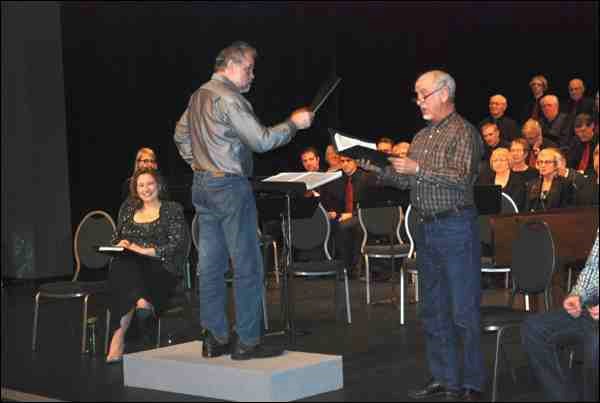The Dekker Cenre was sold out Monday evening for a performance of the holiday classic, Handel's Messiah.
Seventy-five Saskatchewan singers, a 17-piece orchestra and four soloists presented the nearly three-hour masterpiece, one of the best known and most frequently performed choral works in Western music.
Duff Warkentin, who has conducted choirs of all sizes and age groups for his entire adult life, led the performance. Warkentin received his formal post-secondary musical education at Canadian Mennonite Bible College in Winnipeg, University of Waterloo, and the University of Regina.
The voices of the choir were those of the Station Singers, who take their name from their rehearsal and performance space, the Station Arts Centre in the town of Rosthern. Created in 2002, the choir draws singers from Rosthern and area. Conductor Warkentin is known for his passionate belief that culture builds community, and that music and singing needs to be available to all, regardless of age, background or residence. He is known to the Battlefords community from his year as a choral artist in residence in Battlefords in 2000.
The singers were accompanied by Prairie Virtuosi, a classical chamber orchestra based in Saskatoon, founded in 1997. It consists of a collective of professional musicians passionate about creating exciting and inviting orchestra performances that are accessible to everyone. They hold an annual New Year's Day concert and have performed alongside many soloists and ensembles. They have also been recorded and broadcast by CBC Radio.
For Monday's concert, a harpsichord was brought to the Dekker Centre, with transport provided by the Mennonite Youth Farm Bible Camp.
The Messiah score calls for soloists singing baritone, tenor, alto and soprano: Matthew Pauls, presently working on a doctorate of music in voice at the University of Western Ontario; Robert Dick, a Saskatoon resident who has been affiliated with many major choral ensembles in Saskatchewan; Lisa Hornung, well known local teacher, adjudicator, clinician and choral coach; and Barbara Milner, recently featured as a soloist in the Saskatoon Chamber Singers CD, Remember, newly released.
Warkentin told the audience bringing Messiah to the Dekker Centre for the Performing Arts started with an email from Hornung, whom he had invited to sing alto for the Rosthern performance. A second event planned for Saskatoon had fallen through, so Hornung suggested they bring the show to the Battlefords, said Warkentin.
He also credited Rob Rongve and Heath Gabruch of RBC Dominion Securities, the sponsor of the performance, for their support of arts in the community.
In his introduction to the performance, Gabruch said any proceeds from the event would be going toward Caring Communities, a Battlefords and District Community Foundation fund.
Gabruch also referred to the El Sistema music program for youth launched earlier this year with startup funding from RBC Foundation. A number of the young musicians were attending, taking up most of the top row of seats, and received a round of applause from the audience.
Messiah is an English-language oratorio composed in 1741 by George Frideric Handel, with a scriptural text compiled by Charles Jennens from the Old Testament for the first two acts and primarily from the New Testament in the third. It was first performed in 1742 in Dublin, Ireland and debuted about a year later in London, England.
It has since become one of the western world's best known oratorios, famous for its resounding and jubilant Hallelujah chorus, which ends the second of three acts. Following the chorus, one audience member was heard to remark, "It was worth the ticket just for that."
At most performances of Messiah, the audience stands for the Hallelujah chorus, according to the legend that British monarch King George II was so moved by it that he stood, and all must stand when the king does. The legend may or may not be true, but the audience usually appreciates the chance to stand, since the oratorio can be almost three hours long.
The Dekker Centre audience did indeed stand for the Hallelujah chorus, and some even sang along.
The evening ended with a standing ovation by an appreciative audience. According to classical performance etiquette, the audience members were asked to hold their applause to the end so, as Warkentin explained, the story could unfold. When they finally were able to clap, they did so long and loud.

.png;w=120;h=80;mode=crop)


